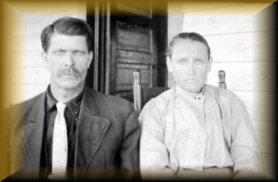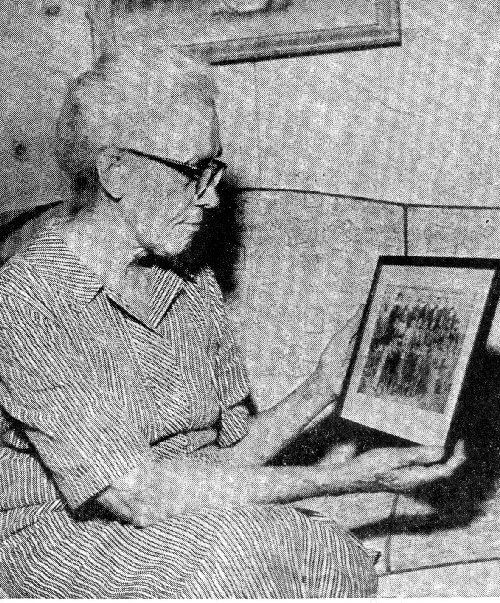
This article was copied from the August 2, 1966 issue of The Cleveland Times.
Employees Of Cleveland Mill & Power Co. Number 1 Plant
Old Picture Captures Childhood Memories For Mrs. D.L. Willis

A group picture taken about 1905 brings back a flood of memories
for Mrs. D.L. Willis of Shelby.
Just before Cleveland Mill and Power Co.'s number 1 Plant closed
operations permanently, a Gastonia photographer lined the 24 employees
up in orderly rows outside the frame building and snapped a picture.
Today that photo is a treasured memento of the past for Cenie Southard
Willis who at that time was 16 years old… and the prettiest girl in the
picture.
The picture also captures the likenesses of her father, Montgomery
Southard, general superintendent and mechanic at the plant; her oldest
brother, John, younger brother, Charles; and sister Minnie. It is a
coincidence that in the picture also is Joe Willis who later was to
become her brother-in-law.
Speaks Volumes
The picture speaks volumes about Cleveland's infant textile
industry of that day since Mrs. Willis recalls that the youngest
employees in the picture are 10 years old and she went to work when she
was 13. Mill Number 1 gained it's name because it was the first textile
plant erected by the late Major H.P. Schenck, about two miles north of
the present community of Lawndale, in an operation that continues today
under the name Cleveland Mills.
Cenie Willis draws a colorful picture in the words of life in the small
textile community where she was reared before the turn of the century.
She does not recall life as hard … and remembers many pleasant events in
years that were lean for everyone in Cleveland county which had not
recovered from effects of the Civil War.
Number 1 Mill was set in a community of about a dozen mill owned houses,
a mill store, a small, two-story frame school, and, of course, a church.
Other homes in the community were those of Tom Ramseur and Joe Osborne,
both of whom had married into the Schenck family.
12-Hour Day
Working hours were from 6 a.m. to 6 p.m. when Cenie Southard was
employed in the two-story, frame yarn mill which was built in a "low
place" beside the First Broad River and used water power to run the two
lines of spinning frames, one line of twisters, one line of spoolers and
ball winders. During the long, dark hours in winter the building was lit
by kerosene lamps and heated by pot-bellied stoves. River water was
piped into the building in a fire protection system but drinking water
was carried from a spring nearby.
"I could do just about any of the jobs there were to do in the mill,"
recalls Mrs. Willis who began at the spinning frames. "I never thought
of the hours or the work as being hard. When we got off work, the young
people played and had fun just as kids do now, after doing nothing all
day."
"But, as I recall those years, I don't believe that we were under the
production pressures such as you find in textile plants now. We would
catch up with our work and have a few minutes to go sit down….like
today's coffee 'break'. And we always had plenty of time to eat for it
was the custom to shut down for dinner with everyone going home promptly
at 12 o'clock," she smiles.
Family Tradition
Working for Cleveland Mills was a tradition in the Southard family. Montgomery Southard was reared in Richmond, Va. and came to Mill Number 1 before he married Mrs. Willis' mother, Allie Mitchem, who was a native of the Lawndale area and worked in the mill prior to her marriage. Mrs. Willis believes that her mother went to work at the mill when she was 16 in 1878, not many years after the plant was founded in 1873. "My father and two of my brothers never drew a paycheck during their lives from any company but Cleveland Mills," she tells.
The Southard family was a large one of 11 children, five boys
and six girls. Sallie Mitchem Southard died when she was only 41 years
old. The oldest daughter, Luster (later Mrs. Jethro Lattimore, who died
just after Christmas last year) took over to manage the large household,
including a baby sister who was only two months old.
"Father never remarried but we managed very well," recounts Mrs. Willis.
"Everyone had to do his part of the work. All the children helped out."
Simple Pleasures
Recreation and leisure hour pleasures were
simple ones in the rural community which had the mill as it's focal
point. The church was a center of religious and social activity, with
Sunday school each Sunday and prayer meeting once each week, although
church services were conducted only once each month, Mrs. Willis tells.
The first Piedmont School served youngsters in the community who
attended school for four years, from the time they were six until they
reached 10. "Free School," as it was called, was conducted for a four
month term each winter and private subscriptions provided an additional
six week term in the summer. Professor Burns was the academic mentor in
the frame two-story school house designed with a large room or
auditorium downstairs for the daily opening exercises. Upstairs the
grades were separated by folding doors which could divide the large room
into classrooms.
Excursions to Shelby were rare pleasures for the young Cenie Southard,
since roads were in such poor condition that the drive which now takes
only a few minutes was a long and hard journey.
A particularly vivid memory was a trip to Shelby in a two horse covered
wagon to enjoy the first and only circus she had ever seen. Her father,
brother and uncle left home at 2 a.m. for the "straw ride" into Shelby
for a day of fun.
It was not too long ago that Mrs. Willis showed her granddaughter the
same type of covered wagon ride in a Raleigh museum and had a hard time
convincing her that she really had ridden in one as a girl.
Other trips to Shelby that stand out in her memory are a Fourth of July
excursion - when it rained all day. And on another occasion Cleveland
Mills gave employees a free trip to town to see a baseball game, which
Mrs. Willis recalls was played on the same field where Shelby Ball Park
now stands. A standout memory is that the trip was made by way of the
Lawndale Railroad, privately owned line that served the Cleveland Mills
enterprises.
Little remains today of the community where Mrs. Willis grew up and
worked as a young girl. It was about the time of the financial panic of
1905 that operations at Mill Number 1 were closed down and all the
Schenck textile manufacturing was centered at the larger brick plant in
Lawndale.
Mrs. Willis recalls that the Number 1 building stood empty for a number
of years and was later dismantled. The mill-owned houses in the
community were dismantled or moved. The particular house in which the
Southard family lived later burned. Cenie Willis' brother had purchased
the house and land which joined his own home and it was destroyed by
fire.
Since her parents before her worked at the Cleveland Mills plant, Mrs.
Willis has heard a number of interesting facets of operation that date
back before her personal memories. Although she never recalls a fire in
the small textile plant, she remembers being told that there was a fire
where men grabbed roping cans and used water from the dam pond to
extinguish the blaze.
Before the time when she was employed at the mill there was a period
when it was in operation around the clock, running night and day.
Milestone
Closing of the plant must have been a milestone
in the lives of those who worked there since it was a family-type
operation with many of the employees related, including a number of
members of the same immediate family, as in the case of the Southards.
But on the very last day of operations Mr.s Willis recalls an amusing
incident centered about the bell that rang to summon employees to work
and for other community events. Since it was a time of financial panic,
or depression, this thought weighed heavily on the minds of all. As a
man pulled heartily on the bell rope, it suddenly broke. The startled
response of a young man who couldn't speak plainly was, 'Dawd, the
panic's hit the bell."
It was two years after the mill closed that Cenie Southard married the
late D.L. "Doc" Willis whom she had known as a child growing up in the
community. The Willis family farm was about six miles away and they had
known each other from the time they were youngsters. Married at 18,
Cenie Willis and her husband moved to Shelby in 1908 where they both
worked for a number of years at Ella Manufacturing Co., the plant
founded by the late John R. Dover Sr. and forerunner of today's Dover
Textile Group.
Life has been full for Mrs. Willis who reared a family of four children,
Floyd, D.L. Willis Jr., the late Roy Willis and a daughter, Ray, who is
Mrs. Snoop Champion.
Today at her home at 415 S. DeKalb St., her green thumb keeps rows of
potted plants and ferns along the edge of her porch while she stays busy
sewing and making buttons for the public.
When Mrs. Willis tells any of her five grandchildren about her youthful
experiences they react as if she has opened the pages of a history book.
But for a woman who looks and acts far younger than her 75 years, a
treasured photograph hanging on the wall of her living room brings alive
the period of life at the turn of the century as if it were yesterday.
